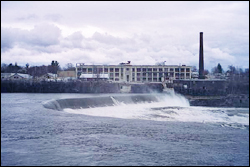|
General Electric is an international company that has business in over 100 countries and has over 300,000 employees. Some of the many industries that GE is responsible for are in aviation, lighting, appliances, medical and technological equipment, television, and, of course, power plants.
General Electric dates back to when Thomas Edison, inventor of the light bulb, started a company named the Edison Electric Light Company in 1874. By 1892, General Electric was founded and has been in big business ever since.
General Electric is also responsible for the dumping of 1.3 million pounds of PCBs into the Hudson River. GE owns two companies in New York, in Hudson Falls and Fort Edward, both up the river near Albany. By 1984, the EPA had declared that the Hudson River was a Superfund site. Two hundred miles of the river were infected with the cancer causing PCBs.
|  |
|
According to the 2001 GE Annual Report, the PCB concentrations in the Upper Hudson river are 40 the accepted level and the health risk involved when eating fish contaminated by PCBs exceeds the EPAs level 1000 times over! In a statement sponsored by religious, private and pension groups, it was recommended that GE take the appropriate responsibility to completely eliminate the PCBs problem. GE's response was that they are environmentally conscious and follow government directives, especially in terms of the Hudson River clean up. However, even now GE is still dumping smaller amounts of PCBs into the river, even though they have been ordered to dredge the river.

|
| General Electric power plant at Hudson Falls, NY |
|
|  |
|
By December 2001, General Electric had been ordered to dredge the upper Hudson River, which means that 2.65 million cubic yards of sediment will be dug up and cleaned of contamination. This would be enough dirt to fill 10 football fields up to 145 feet high!! This cleanup is expected to cost GE about $460 million.
General Electric is opposed to this order. GE feels that they have done enough for the environment, and spent much money, and that disturbing the PCB sediment will cause greater ecological damage than the damage that's already been done. In other words, they feel that moving around the contaminated sediment will have a worse effect on the environment because PCB levels in the water are considered acceptable.
|
|
|


